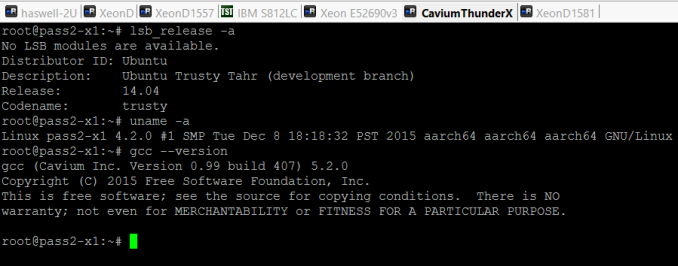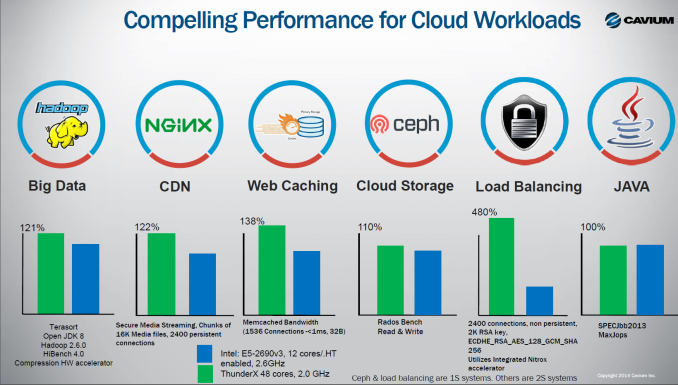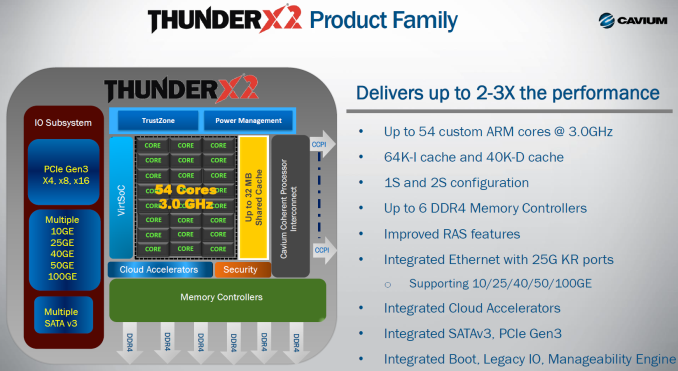Investigating Cavium's ThunderX: The First ARM Server SoC With Ambition
by Johan De Gelas on June 15, 2016 8:00 AM EST- Posted in
- SoCs
- IT Computing
- Enterprise
- Enterprise CPUs
- Microserver
- Cavium
Limitations of This Review
Before we get to our closing thoughts, I want to talk a bit about what we were and weren't able to do in our testing, and in what ways this limits our review. The still somewhat "rough on the edges" software ecosystem gave us a lot of headaches. Our setup was a Ubuntu 14.04 with lots of customized (Cavium's beta gcc compiler, MySQL version ThunderX 5.6) and newer software (the Linux kernel 4.2). The result was that we were slowed down by a large number of solvable (but time consuming) software and configuration problems.
Don't get me wrong: Linux on ARM has come a long way. Most software works, the exception was Spark 1.5 (Java based) which crashed with a very low level message. Still, it took quite a bit of time to get software configured correctly, while on x86 it is simply a matter of using "apt-get install".
Cavium told us that they expect that these problems will be solved in Ubuntu 16.04, and a firmware upgrade to support the new Ubuntu is on its way. That is also why we were not able to test our most real world and relevant benchmarks, such as our webserver tests. Webcaching, light webserving and Contend Delivery Networking might fit the ThunderX well as it has access to more memory and networking bandwidth than the Xeon D.
But webservers require a lot of software components (caching layer, webserver, interpreter etc.) that have to work together well. So we wait for 16.04 and the new firmware to arrive to build these complex tests.
Closing Thoughts
Exploring a new ambitious server SoC is always an interesting journey, but also a very time intensive one. We had to find out what the real performance profile of the ThunderX, not the perceived or advertised one. There have been both good and bad surprises in our journey.
Let's start with the bad: the blocking L1 cache, high latency L2-cache and high latency DRAM access are lowering the scalability of the 48 cores in a whole range of software. The ThunderX could still be a good candidate as front-end webserver, but Cavium has to solve the high power usage at low loads. Power management seems to be more problematic than single-threaded performance. Cavium promises that ThunderX2 will vastly improve power management by letting hardware handle much more of the management duties. But the current ThunderX power management capabilities seem to be rather basic. Cavium's information is sketchy at best.
The Xeon D, by comparison, offers superior performance per watt: twice as good as the ThunderX. It is clear that the ThunderX is not a good match for heavy database servers, nor for enterprise workloads where energy consumption at low load is a high priority.
The good. The 12 and 16-core Xeon Ds ($1300-$1800) and midrange E5s ($900-$2000, not including 10 GBe NICs) cost quite a bit more than the ThunderX ($800). Gigabyte could not tell us how much the R120-T30 would cost, only that the pricing would be "competitive with similar midrange Xeon E5 servers".
Although single-threaded performance is low, it is definitely not as terrible as commonly assumed. We found out that the raw integer computing power of the Thunder-X is about one-third that of the best Xeon Ds, not one-fifth as claimed in advertising materials (a difference of 65%). The ThunderX core is almost as good as the A57, while it consumes quite a bit less power and thus offers a better performance-per-watt than the latter. On the condition that you give it enough DRAM, the 48 cores are able to offer the Java performance of a midrange Xeon E5, even when we expect the system to remain under a certain response time.
Those facts – better than expected single threaded performance and midrange Xeon E5 throughput – make a world of difference. And we have yet to test the ThunderX in situations that is was really built for: network-intensive ones. The XML processing and h264 substests (SPEC CPU) indicate that there is definitely some truth in Cavium's claims that the ThunderX shines as a compute engine of a load balancer, web cache or CDN server.
As single threaded performance (SPEC CPU) is not as dramatic as commonly assumed and Java performance is already very close to what was promised, this puts the forthcoming ThunderX2 in a different light.
Using the new 14 nm FinFET technology of GlobalFoundries, Cavium claims it will reach 2.6-3.0 GHz and get a lot of microarchitectural improvements. This should result in twice as much performance per core. If indeed the ThunderX2 can offer single threaded performance at the level of the low end Xeon D (1.3-1.5 GHz), that might place it in the "SoCs with acceptable single threaded performance" and opens up new markets. Time will tell, but Cavium has proven it can deliver SoCs in a timely manner. And the fact that Cavium allows independent testing instead of just showing numbers on PowerPoint presentations tell us that they have confidence in the future of their ARMv8 endeavors.













82 Comments
View All Comments
silverblue - Thursday, June 16, 2016 - link
I think AMD themselves admitted that the Opteron X1100 was for testing the waters, with K12 being the first proper solution, but that was delayed to get Zen out of the door. I imagine that both products will be on sale concurrently at some point, but even with AMD's desktop-first approach for Zen, it will probably still come to the server market before K12 (both are due 2017).junky77 - Thursday, June 16, 2016 - link
still, quite strange, no? AMD is in the server business for years. I'm not talking about their ARM solution only, but their other solutions seem to be less interesting..silverblue - Thursday, June 16, 2016 - link
I am looking forward to both Zen and K12; there's very little chance that AMD will fail with both.name99 - Wednesday, June 15, 2016 - link
" It is the first time the Xeon D gets beaten by an ARM v8 SoC..."The Apple A9X in the 12" iPad Pro delivers 40GB/s on Stream...
(That's the Stream built into Geekbench. Conceivably it's slightly different from what's being measured here, but it delivers around 25GB/s for standard desktop/laptop Intel CPUs, and for the A9 and the 9" iPad's A9X, so it seems in the same sort of ballpark.)
aryonoco - Thursday, June 16, 2016 - link
Fantastic article as always Johan. Thank you so much for your very informative articles. I can only imagine how much time and effort writing this article took. It is very much appreciated.The first good showing by an ARMv8 server. Nearly 5 years later than expected, but they are getting there. This thing was still produced on 28 HKMG. Give it one more year, a jump to 14nm, and a more mature software ecosystem, and I think the Xeons might finally have some competition on their hands.
JohanAnandtech - Thursday, June 16, 2016 - link
Thank you, and indeed it was probably the most time consuming review ... since Calxeda. :-)Yes, there is potential.
iwod - Thursday, June 16, 2016 - link
Even if the ThunderX is half the price of equivalent Xeon, I would still buy Intel Xeon instead. This isn't Smartphone market. In Server, The cost memory and Storage, Networking etc adds up. Not only does it uses a lot more power in Idle, the total TCO AND Pref / Watts still flavours Intel.There is also the switching cost of Software involved.
And those who say Single Core / Thread Performance dont matter have absolutely no idea what they are talking about.
As far as I can tell, Xeon-D offers a very decent value proposition for even the ARM SoC minded vendors. This will likely continue to be the case as we move to 10nm. I just dont see how ARM is going to get their 20% market share by 2020 as they described in their Shareholder meetings.
rahvin - Thursday, June 16, 2016 - link
If you have to switch software on your severs because you switch architecture you are doing something wrong and are far too dependent on proprietary products. I'm being a bit facetious here but the only reason architecture should limit you is you are using Microsoft products or are in a highly specialized computing field. Linux should dominate your general servers.kgardas - Friday, June 17, 2016 - link
Even if you are on Linux, still stack support is best on i386/amd64. Look at IBM how it throws a lot of money to get somewhere with POWER8. ARM can't do that, so it's more on vendors to do that and they are doing it a little bit more slowly. Anyway, even AArch64 will mature in LLVM/GCC tool chain, GNU libC, musl libC, linux kernel etc but it'll take some time...tuxRoller - Thursday, June 16, 2016 - link
Aarch64 has very limited conditional execution support.http://infocenter.arm.com/help/index.jsp?topic=/co...